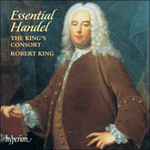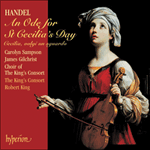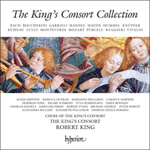
Welcome to Hyperion Records, an independent British classical label devoted to presenting high-quality recordings of music of all styles and from all periods from the twelfth century to the twenty-first.
Hyperion offers both CDs, and downloads in a number of formats. The site is also available in several languages.
Please use the dropdown buttons to set your preferred options, or use the checkbox to accept the defaults.

Much of the text and a little of the musical material for Cecilia, volgi is taken from Splenda l’alba in oriente. As first composed the cantata consisted of two arias with introductory recitatives, all for Arrigoni’s tenor voice, followed by a soprano recitative for Strada and the final duet. Obviously this was not a satisfactory structure from Strada’s point of view, and so before performance Handel added another recitative for her and inserted the aria ‘Sei cara, sei bella’, the music of which was simply a slightly trimmed version of the aria ‘Sweet accents’ from the earlier abandoned addition. When the full score of Alexander’s Feast was published by Walsh in 1738, Cecilia, volgi was printed in an appendix, together with an additional aria ‘Sei del ciel’, probably inserted for the mezzo-soprano castrato Domenico Annibali when the ode and the cantata were repeated in 1737. The first aria of the cantata is modestly accompanied with continuo alone, perhaps as a deliberate contrast to the powerful chorus ‘The many rend the skies’ that preceded it at the end of Part 1 of Alexander’s Feast. It nevertheless tests the tenor voice with a highly elaborate vocal line. The next aria, based on the opening aria of Splenda l’alba in oriente and using the same text, has a lively triple-time rhythm, with an accompaniment of full strings. ‘Sei cara’, the soprano aria, has a variety of effects within itself. The main section is mostly in fast tempo, with a vocal line dominated by long, florid runs, but it is divided into two statements, each begun with the opening words set in a slow tempo, inviting additional vocal embellishment. In the middle section, originally composed as a reflection on the mysterious power of music, a new and unexpected mood of ravishing intensity is ushered in by a change to a minor key and the entry of the full strings. Shifting harmonies help to create a musical equivalent of the rapt, heavenward-gazing image of Cecilia found in many Renaissance paintings. The cantata closes in lighter style, with jaunty, syncopated rhythms bringing a sense of playfulness to the final duet. Handel’s last cantata with orchestral accompaniment celebrates the joint themes of music and virtue with engaging warmth.
from notes by Anthony Hicks © 2004
Une grande partie du texte et un peu du matériau musical de Cecilia, volgi est tiré de Splenda l’alba in oriente. Telle qu’elle était initialement composée, la cantate consistait en deux airs avec des récitatifs introductifs pour la voix ténor d’Arrigoni. Ils étaient suivis par un récitatif de soprano pour Strada et le duo final. Bien évidemment, du point de vue de Strada, la structure de l’œuvre n’était guère satisfaisante, si bien qu’avant la représentation, Haendel ajouta un autre récitatif pour elle et inséra l’aria «Sei cara, sei bella», dont la musique était une version légèrement écourtée de l’air «Sweet accents», une addition antérieure à laquelle il avait renoncé. Quand la partition complète de Alexander’s Feast fut publiée par Walsh en 1738, Cecilia, volgi fut imprimée en appendice, avec l’air additionnel «Sei del ciel», probablement inséré pour le castrat Domenico Annibali, à la tessiture de mezzo, lorsque l’ode et la cantate furent reprises en 1737. Le premier aria de la cantate est accompagné légèrement par le seul continuo, peut-être pour contraster délibérément avec la puissance du chœur «The many rend the skies» qui le précédait à la fin de la Premier Partie d’Alexander’s Feast. Il s’agit néanmoins d’un test pour la voix de ténor avec une ligne vocale hautement élaborée. L’air suivant, élaboré sur l’aria initiale de Splenda l’alba in oriente et se servant du même texte, dénote un rythme ternaire animé, avec un accompagnement des cordes au complet. «Sei cara», l’air de la soprano, possède une grande variété d’effets. La section principale est écrite dans un tempo généralement rapide, avec une ligne vocale dominée par de longs traits florides. Elle se divise en deux énoncés, chacun débutant avec les mots du début énoncés dans un tempo lent, invitant des ornements vocaux supplémentaires. Dans la section centrale, initialement écrite comme une méditation sur le pouvoir mystérieux de la musique, une atmosphere nouvelle et inattendue d’une intensité fort séduisante est introduite par le biais d’une modulation en mineur et de l’entrée des cordes au complet. Des changements harmoniques contribuent à suggérer musicalement le ravissement, l’image céleste de Cécile qui regarde des cieux telle qu’on la voit dans les tableaux de la Renaissance. La cantate se conclut dans un style plus léger, avec des rythmes gais et syncopés qui introduisent une sensation ludique dans le duo final. La dernière cantate de Haendel avec accompagnement orchestral célèbre les thèmes réunis de la musique et de la vertu avec une cordialité et vivacité engageantes.
extrait des notes rédigées par Anthony Hicks © 2004
Français: Isabelle Battioni
Ein Großteil des Texts und auch ein kleiner Anteil des musikalischen Materials von Cecilia, volgi stammt aus Splenda l’alba in oriente. In ihrer ursprünglichen Form bestand die Kantate aus zwei Arien, jeweils mit einleitenden Rezitativen, für Arrigonis Tenorstimme, gefolgt von einem Rezitativ für Sopran und dem Schlussduett. Natürlich war dies für Strada keine ideale Aufteilung, so dass Händel vor der Aufführung für sie noch ein Rezitativ und die Arie „Sei cara, sei bella“ (eine etwas verkürzte Fassung der Arie „Sweet accents“ des früheren, verworfenen Einschubs) hinzufügte. In der Walsh-Ausgabe der Partitur des Alexander’s Feast von 1738 ist Cecilia, volgi im Anhang zusammen mit „Sei del ciel“ abgedruckt. Letzteres wurde wahrscheinlich für den Mezzosopran-Kastraten Domenico Annibali eingefügt, der bei der Wiederholungsaufführung der Ode und der Kantate 1737 mitwirkte. Die erste Arie der Kantate wird lediglich von der Continuo-Gruppe begleitet. Möglicherweise fällt die Besetzung deshalb so bescheiden aus, damit der Kontrast zu dem großartigen vorangehenden Schlusschor des ersten Teils von Alexander’s Feast, „The many rend the skies“, umso stärker wirkt. Trotzdem hat die Tenorstimme in der Arie eine besonders kunstvolle Melodie zu bewältigen. Die nächste Arie hat einen lebhaften Dreierrhythmus und der Solist wird von dem gesamten Streicherapparat begleitet. Sowohl der Text als auch das musikalische Material basieren auf der ersten Arie von Splenda l’alba in oriente. In „Sei cara“, der Sopran-Arie, kommen mehrere Effekte zum Ausdruck. Der Hauptteil ist fast durchgängig in schnellem Tempo zu musizieren, wobei der Vokalpart lange, verzierte Läufe hat, jedoch in zwei Teile geteilt ist, die jeweils mit den Anfangsworten in langsamen Tempi beginnen, die sich wiederum sehr für Verzierungen eignen. Im Mittelteil, der ursprünglich die Funktion hatte, über die geheimnisvolle Kraft der Musik zu reflektieren, wird eine neue und unerwartete Stimmung von besonderer Intensität mit einer Molltonart und dem Einsatz der gesamten Streicher eingeleitet. Mit Harmoniewechseln wird das selbstvergessene, gen Himmel schauende Bild der Cäcilia, wie es in vielen Renaissance-Gemälden zu sehen ist, musikalisch dargestellt. Die Kantate endet in einem leichteren Ton; schwungvolle, synkopierte Rhythmen verleihen dem Schlussduett eine spielerische Note. In seiner letzten Kantate mit Orchesterbegleitung feiert Händel die hier gekoppelten Sujets der Liebe und Tugend auf reizende Art und Weise.
aus dem Begleittext von Anthony Hicks © 2004
Deutsch: Viola Scheffel
 Handel: Essential Handel Handel: Essential Handel'here's a good, cheap way to support a company that has immeasurably enriched the collections of legions of record buyers over a quarter of a century ...» More |
 Handel: An Ode for St Cecilia’s Day Handel: An Ode for St Cecilia’s Day |
 The King's Consort Collection The King's Consort Collection'An uplifting disc, and nicely presented—I can certainly recommend this as an example of both fine music and exquisite performances' (MusicWeb Interna ...» More |

